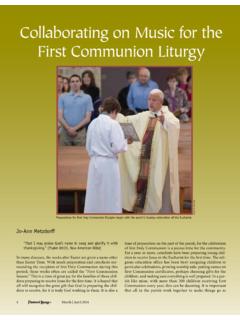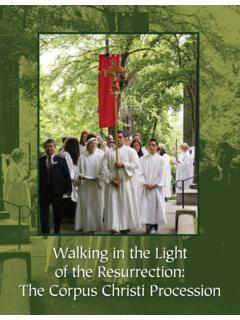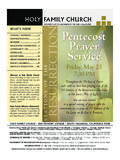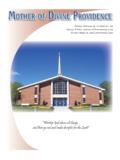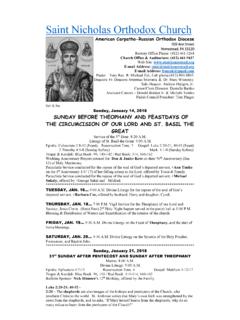Transcription of Does the Catholic Church Allow Cremation? - …
1 Indeed, the Catholic Church allows for the option of cremat-ing the body of the deceased person. However, the preference is that the body be buried (Order of christian Funerals [OCF], Appendix, 414). Theologically, the physical body has a dignity of its own. This dignity is expressed, ritually and liturgically, by way of incensing, sprinkling, touching, prayer over the body, gathering with the body, and so on, during funeral liturgies, vigils, and burials. These rituals show that, indeed, the christian community affirms the dignity, worth, and care of the one who awaits the final Resurrection of the dead. The human body is deser v i ng of reverence, whether alive or Church , moreover, clearly pre-fers that the body be present for the funeral liturgy, even though crema-tion may be an option. The Church asks that, following the funeral lit-urgy, but before the rite of committal (that is, burial or interment), the body may be cremated. During the vigil or wake and at the funeral liturgy, the body is present.
2 Then, the body may be taken to be cremated, and buried or remains cannot be scattered or displayed in the home (OCF, Appendix, 417), rather, the remains are to be buried or interred, especially in a cemetery, mausoleum or columbarium (417). These are places where people can go to offer prayers for the deceased and mourn the physical loss. These spaces provide the psychological and spiritual separa-tion between the deceased and the living, as well as the recog-nition that, even though deceased, this person is still a part of the Church . These spaces recognize that the Church is more than just the living but includes those who have gone before us in death and who await the final Resurrection of the those cases when the body cannot be present for the liturgy, but the cremated remains will be at the funeral liturgy, the Church offers an appendix to the Order of christian Funerals the ritual compendium of liturgies, rites, and 2009 Archdiocese of Chicago: Liturgy Training Publications, 1800 North Hermitage Avenue, Chicago, IL 60622; 1-800-933-1800; Art by Martin Erspamer, osb (formerly known as Steve Erspamer, sm).
3 All rights reserved. Used with permission. Pastoral Liturgy magazine, July/August 2009, page may be reproduced for personal or parish use. The copyright notice must appear with the text. It also may be downloaded at the Catholic Church Allow Cremation? Kristopher Seamanprayers from the time of death to final burial. This appendix provides options for the presence of cremated remains. It states that the cremated remains of the body are to be placed in a worthy vessel. A small table or stand is prepared for them at the place normally occupied by the coffin. The vessel con-taining the cremated remains may be carried to its place in the entrance procession or may be placed on this table or stand sometime before the liturg y begins (427). A burial pall is not placed over the worthy vessel of the cremated remains. Many parishes now have ossuaries into which the cremated remains are placed as a way to contain, in a worthy man-ner, the cremated Baptism, discipleship began.
4 Discipleship continues throughout life, and does not end at death. God s overflowing love in Jesus the Christ remains faithful to his covenant. God will not let death have the final word (4). Death does not extinguish life but changes one s relationship to God and to one another. The physical body has a dignity of its own, because death does not sever the bonds of disciple-ship with God or with one another. One now lives differ-ently, awaiting the final Resurrection. We, who mourn the death of another human person, pray that this person may be worthy of God s abundant life in a new way. Death is not an end, but a transition into a new or changed way of having life in Christ Jesus. Cremation, while allowed, does not express the full dignity that God and humanity has for the deceased. Having the body present for the vigil and funeral liturgy, affords the community of disciples that is, the Church to express their grief, loss, prayers, and hopes for the new life of one who is born into eternal life.
5 Kr i s t o p h e r se a m a n is the associate director of the Office of Worship for the diocese of Gary.

